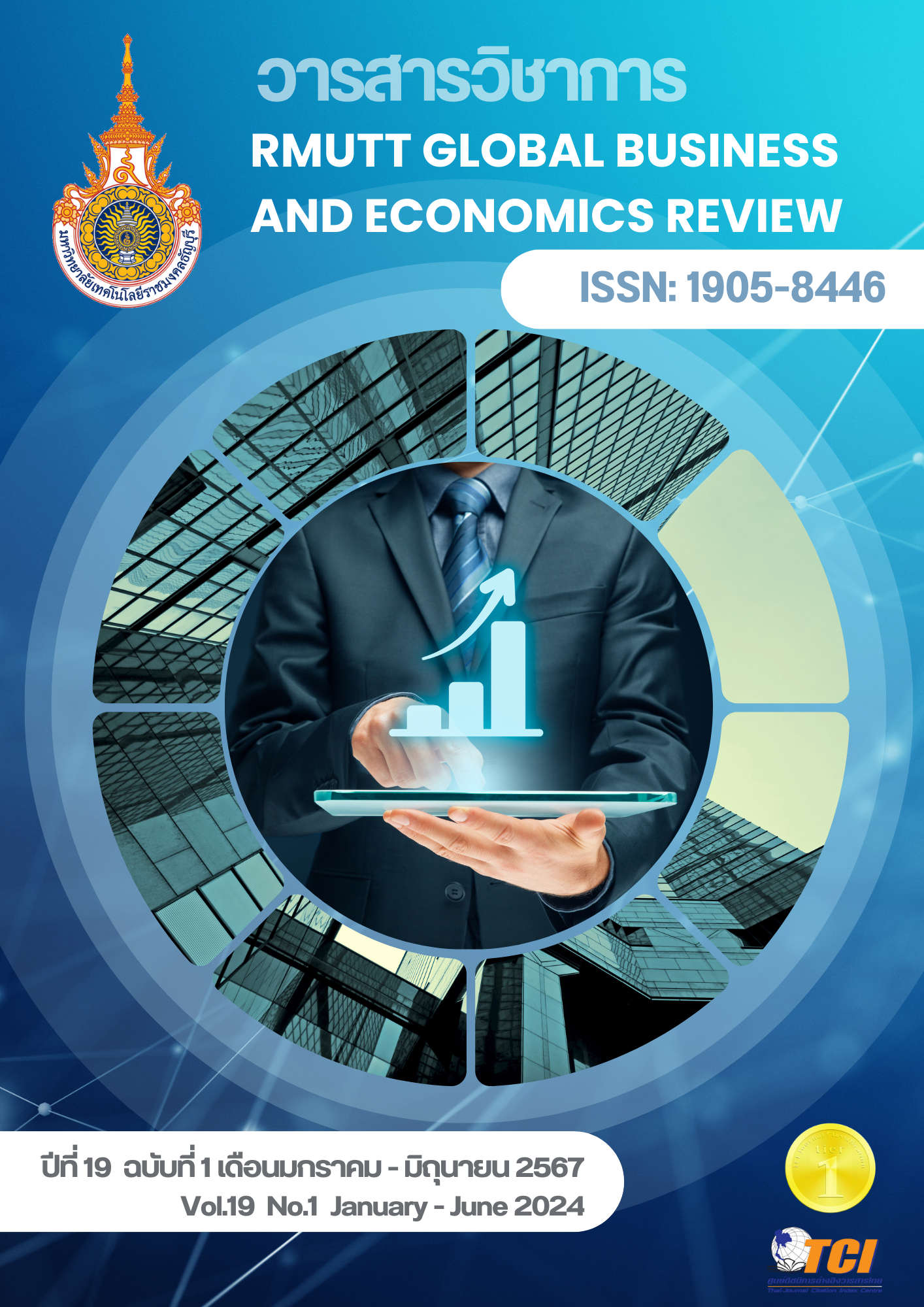EXPORT DEMAND FOR THAILAND'S KING OF FRUIT
DOI:
https://doi.org/10.60101/rmuttgber.2024.269208Keywords:
Export, Gravity Model, King of Fruit, DurianAbstract
This paper aims to find the determinant of Thailand’s king of fruit exports based on the gravity model. Several primary econometrics methods apply to the gravity model applying to Thailand’s durian export. The result indicates that the country-pair and time-fixed effect PML with interaction regarding the landlock and time dummy variables give the most logical results. The empirical results suggest that enhancing labor productivity in durian cultivation is a strategy to increase durian cultivation and export. Durian exporters might use the lower price strategy to enhance their income. Thailand’s durian exporters should find a specific country in each income-level group where most people love durian.
References
Anderson, J. E. (1979). A theoretical foundation for the gravity equation. American Economic Review, 69(1), 106-116.
Anderson, J. E., & Wincoop, E. V. (2003). Gravity with gravitas: A solution to the border puzzle. American Economic Review, 93(1), 170-192.
Anderson, J. E., & Yotov, Y. V. (2016). Terms of trad and global efficiency effects of free trade agreements, 1990-2002. Journal of International Economics, 99, 279–298.
Baier, S. L., & Bergstrand, J. H. (2007). Do free trade agreements actually increase members’ international trade?. Journal of International Economics, 71(1), 72-95.
Batra, A. (2006). India’s global trade potential: the gravity model approach. Global Economic Review, 35(3), 327–361. https://doi.org/10.1080/12265080600888090
Bergstrand, J. H. (1985). The gravity equation in international trade: Some microeconomic foundations and empirical evidence. Review of Economics and Statistics, 67(3), 474-81.
Borchert, I., & Yotov, Y. V. (2017). Distance, globalization, and international trade. Economics Letters, 153, 32–38.
Caporale, G. M., Sova, A., & Sova, R. (2015). Trade flows and trade specialization: The case of China. China Economic Review, 34, 261–273. https://doi.org/10.1016/j.chieco.2015.03.010
Castillo, J. S., Villanueva, E. C., & Garcia-Cortijo, M. C. (2016). The international wine trade and its new export dynamics (1988–2012): a gravity model approach. Agribusiness: An International Journal, 32(4), 466–481. https://doi.org/10.1002/agr.21463
Cheong, J., Kwak, D. W., & Tang, K. K. (2016). The distance effects on the intensive and extensive margins of trade over time. Empirical Economics, 50, 253–278. https://doi.org/10.1007/s00181-015-0927-x
Dai, M., Yotov, Y. V., & Zylkin, T. (2014). On the trade-diversion effects of free trade agreements. Economics Letters, 122(2), 321-25. https://doi.org/10.1016/j.econlet.2013.12.024
De Matteis, M. C., Yu, T. E., Boyer, C. N., & Delong, K. L. (2018) Analyzing determinant of US distillers dried grains with solubles exports. Agribusiness: An International Journal, 35(2), 168-181. https://doi.org/10.1002/agr.21575
Deardorff, A.V. (1998). Determinations of bilateral trade: Does gravity work in a neoclassical world? In: Frankel, J. A., ed., The Regionalization of the World Economy, pp. 7-32. University of Chicago Press, Chicago.
Dreyer H., & Fedoseeva, S. (2016). Gravity models and asymmetric exchange rate effects: Insights from German beer exports. Agribusiness: An International Journal, 32(2), 289-295.
Fally, T. (2015). Structural gravity and fixed effects. Journal of International Economics, 97(1), 76-85.
Helpman, E. (1984). Chapter 7 increasing returns, imperfect markets, and trade theory. In Jones, R. W. and P. B. Kenen (eds.), Handbook of International Economics, 325-365. https://doi.org/10.1016/s1573-4404(84)01010-8
Kahouli, B., & Maktouf, S. (2014). The link between regional integration agreements, trade flows and economic crisis: A static and dynamic gravity model. International Journal of Development Issues, 13(1), 35-58. https://doi.org/10.1108/IJDI-11-2013-0082
Li, L., Sun, Z., & Long, X. (2019). An empirical analysis of night-time light data based on the gravity model. Applied Economics, 51(8), 797–814. https://doi.org/10.1080/00036846.2018.1523612
Linnemann, H. (1966). An econometric study of international trade flows. North-Holland Pub. Co.
Parra, M. D., Martinez-Zarzoso, I., & Suarez-Burguet, C. (2016). The impact of FTAs on MENA trade in agricultural and industrial products. Applied Economics, 48(25), 2341-2353. https://doi.org/10.1080/00036846.2015.1119792
Persson, M., & Wilhelmsson, F. (2015). EU trade preferences and export diversification. The World Economy, 39(1), 16–53. https://doi.org/10.1111/twec.12354
Poncet, S. (2006). Economic integration of Yunnan with the Greater Mekong subregion. Asian Economic Journal, 20(3), 303-17. https://doi.org/10.1111/j.1467-8381.2006.00237.x
Santos Silva, J. M. C., & Tenreyro, S. (2006). The log of gravity. Review of Economics and Statistics, 88(4), 641-658. https://doi.org/10.1162/rest.88.4.641
Sarker, R., & Jayasinghe, S. (2007). Regional trade agreement and trade in agri-food products: evidence for the european union from gravity modeling using disaggregated data. Agricultural Economics, 37(1), 93-104. https://doi.org/10.1111/j.1574-0862.2007.00227.x
Shabbir, G., Naveed, A., Ali Khan, M., & Syed, S. H. (2022) Does peace promote bilateral trade flow? An economic analysis of panel data in asian perspective. Comparative Economics Studies, 64, 143-158. https://doi.org/10.1057/s41294-021-00155-2
Sheng, Y., Tang, H .C., & Xu, X. (2014). The impact of the ACFTA on ASEAN-PRC trade: Estimates based on an extended gravity model for component trade, Applied Economics, 46(19), 2251-2263. https://doi.org/10.1080/00036846.2014.899676
Tinbergen, J. (1962). Shaping the world economy: Suggestions for an international economic policy (3rd ed.). The Twentieth Century Fund.
Westerlund, J., & Wilhelmsson, F. (2011). Estimating the gravity model without gravity using panel data. Applied Economics, 43(6), 641-649. https://doi.org/10.1080/00036840802599784
Yang, S., & Martinez-Zarzoso, I. (2014). A panel data analysis of trade creation and trade diversion effects: The case of ASEAN-China free trade area. China Economic Review, 29, 138-151.
Downloads
Published
How to Cite
Issue
Section
License
Copyright (c) 2024 ภูมิฐาน รังคกูลนุวัฒน์

This work is licensed under a Creative Commons Attribution-NonCommercial-NoDerivatives 4.0 International License.
บทความที่ได้รับการตีพิมพ์เป็นลิขสิทธิ์ของผู้นิพนธ์
ข้อความที่ปรากฏในบทความแต่ละเรื่องในวารสารวิชาการเล่มนี้เป็นความคิดเห็นส่วนตัวของผู้เขียนแต่ละท่านไม่เกี่ยวข้องกับมหาวิทยาลัยเทคโนโลยีราชมงคลธัญบุรี และคณาจารย์ท่านอื่นๆในมหาวิทยาลัยฯ แต่อย่างใด ความรับผิดชอบองค์ประกอบทั้งหมดของบทความแต่ละเรื่องเป็นของผู้เขียนแต่ละท่าน หากมีความผิดพลาดใดๆ ผู้เขียนแต่ละท่านจะรับผิดชอบบทความของตนเองแต่ผู้เดียว







